ęprevious pageRESEARCH CATEGORY
Species Evolution On Steep Sloped Green Roofs
Michigan State University, East Lansing, MI
faculty advisor: Joanne Westphal, FASLA
Project Statement
Steep Sloped Green Roof research is virtually non-existent. This study will influence the development of green roof design and implementation nationally by describing the ecological succession that we might expect among twelve varieties of sedum in a steep green roof system.
Project Narrative
Our group investigated the relationships between steep-sloped green roofs, green roof sedum species, and the orientation (aspect) of the particular green roof. From this research, we specifically focused on the evolution of the tested sedum species pre-engineered into the tested XeroFlor mats, dominance of those particular species, and the overall percent coverage of the different species present on the steep-sloped green roof. The results will not only benefit the broad field of green roof studies, but more importantly, serve as a foundation for future research and development of steep-sloped green roofs.
Problem Statement
This project revolves around steep-sloped green roofs, addressing plant evolution occurring on a standard XeroFlor mat (originally containing 12 different species) under three different conditions and/or aspects. The first condition involves a two percent slope on a west aspect; this area involves remnant pieces of XeroFlor mats covering approximately 303.3 square feet. The second condition involves a 45% percent slope on a south aspect, covering approximately 303.3 square feet. The third condition involves a 45% percent slope on a north aspect, covering approximately 303.3 square feet. XeroFlor mats were installed on both the north and south facing slopes in August 2005; all conditions initially started with 100% mat coverage with twelve different sedum species. Over the past three years, trends show that the plant coverage on the north side of the roof has flourished, while the flora on the south side has diminished, not only in species coverage, but also in species diversity. With preliminary research, we noticed that the decrease in plant coverage was due to a lack of consistent moisture, intensity of sun exposure, and extreme temperatures. Overall, the main objective for our research is to identify the existing sedum species and to find the percent coverage of the north and south steep-sloped roofs, and the flat roof. The flat remnant mats will be used as a control in order to compare our results from the steep sloped sections. This will allow us to see how the XeroFlor mats perform under different conditions of aspect, sun exposure, and variations of slope. It will also help establish the likely successions of twelve sedum species when placed on steep sloped green roofs at different aspects and intensities of sunlight.
Comparisons with Past Research/Applicability to Landscape Architecture Practice/Significant Issues
Steep green roof design and implementation is a relatively new field of research for landscape architects and ecological designers. Browsing multiple journals, our group has gathered information pertinent to species diversity, composition, roof implementation, and the environmental effects and benefits of green roofs. Green roofs were used as early as 500 BC as an inexpensive indigenous roofing system (Getter, 2006). Hundreds of years later, we continue to enjoy their beneficial effects but for different reasons. Contemporary research regarding construction has revealed their environmental effects by reducing urban heat island effects and improving of thermal conservation. Showcasing Europe's dedication to the development of green roofs, in Basel, Switzerland, for instance, an amendment requiring all newly constructed flat roofs to be built with a green roof was implemented in 2002 (Brenneisen, 2006); in the spring of 2008, our class experienced an extensive test roof first hand with guidance by green roof research specialist, Kare Herfindal, helping us to see the evolution of research occurring overseas.
However, one missing component we noticed throughout our trip and through our previously conducted research was the lack of information concerning green roof systems on steep sloped roofs.
Within the United States, all roofs constitute 32% of built surfaces within urban and rural environments (Oberndorfer, 2007); a substantial portion of this statistic resides on residential rooftops with conventional steep sloped roofs (greater than 10 % slope). To address the reduction of built surfaces in context to environmental and urban design problems, this experiment aims to catalyze research involving steep sloped roofs. With a thorough review of green roof systems, our research on plant succession dynamics will give green roof technology a foundation for future study on steep roof environments. This information will enhance the knowledge of practicing professionals and untrained enthusiasts interested in the design and development of green roofs. This aspect of research is relatively new in context to the already conducted research of flat green roof design and is what we believe to be the next step for a well-rounded understanding of vegetated roof design.
In order to contribute to the initial research phases for steep sloped green roof design, the guidelines for the construction of green roofs must address issues such as roof stability, erosion factors, sun aspect (roof orientation), and the species' rates of establishment. Especially in instances of larger, intensive green roofs, irrigation plays an important role in roof design and adds a need for plant knowledge and technical experience (Hermy, 2006). Green roof species are also a key focus for residential green roof design in order to concentrate on the particular species' chances for survival and effectiveness. Knowing which species are more apt to survive and establish in the existing environmental conditions is imperative for successful green roof implementation, particularly when referencing steep sloped roofs. According to Michigan State University and green roof researchers, Kristin Getter and Bradley Rowe, a plethora of sedum species with positive rates of survival on flat roofs are in the pre-engineered XeroFlor mats that were used in our experiment: Sedum acre, Sedum album, Sedum ellacombianum, Sedum floriferum, Sedum pulchellum, Sedum reflexum, Sedum sexangulare, and Sedum spurium. With these species' outstanding rates of survival on traditionally, flatter green roofs, we will be able to begin comparing specific species and their vitality on both types of roofs. By designing our research to focus on species' survival on sloped surfaces, facing two different aspects, and comparing these observations to the growth of vegetation on a flat, control roof, our research can help improve the foundation for the development of green roofs onto different types of roof environments.
In addition, the creation of a point frame and an organized method of data collection will aid in future observations for those interested in the fields of steep sloped green roof systems. For instance, this frame could potentially provide a template for new products within this field of data collection, helping to develop a marketable industry of steep sloped roofs. Other products our experiment could help create are more efficient XeroFlor mats that integrate a careful blend of sedum species to more clearly address specific microclimate limitations of a roof due to slope, aspect, and sun exposure. Lastly, our experimentation could potentially market an informational guide for residents and businesses looking to construct houses or other buildings, to illustrate the positive effects of constructing green roofs, such as, the creation of wildlife habitats, water storage systems, reducing the negative impacts of the urban heat island effect, and energy conservation. It is these products and ideals that emphasize how our methods of research and collection will establish a solid foundation for future research within the green roof industry to ultimately benefit architects, designers, engineers, and more.
Relationships Investigated
After the literature was thoroughly reviewed, we explored several different relationships that could potentially exist between the sedum species and organized them into three central hypotheses:
H1 - There will be greater species diversity on the control roof followed by the north and little species diversity on the south.
H2 - There will be greater overall percentage coverage on the control roof followed by the north, and little species diversity on the south.
H3 - Different species will predominant on different roof tops due to differences in environment.
Method of Inquiry
Step 1: Gain knowledge on the different species of sedum that would potentially exist on the green roof in terms of plant morphology (identifying characteristics such as leaf structure, flowering head, etc) and environmental requirements.
- Literature review of other green roof case studies and experiments.
- Expert witnesses, Brad Rowe and Kristen Getter, current green roof researchers. Graduate students, Erik Cronk and Jeremiah Johnson, doing related steep sloped green roof studies. Clayton Rugh, CEO XeroFlor provided data that 12 species were pre-engineered into the XeroFlor mats: Hylotelephium verticillatum, Hylotelephium spectabile, Saxifraga granulate, Sedum acre, Sedum album, Sedum ellacombianum, Sedum floriferum, Sedum Kamtschaticum, and Sedum reflexum.
- Studied existing field plots.
Step 2: Established problem statement and tentative hypotheses.
Step 3: Set goals, objectives and standards and criteria.
Step 4: Established our field methodology to meet our goals, objectives, and standards and criteria to test our predicted hypotheses.
- Constructed metal point frame, the main instrument that we will use to collect data. The set of frames are 3 feet by 3 feet square constructed with aluminum. Small holes will be drilled 3 inches on center on each side of the square. Strong fish line will then be thread through each hole, therefore setting up a grid. At the intersections of each grid a point probe will be dropped and all species that touch the probe will be recorded. All recording will be placed into a pre-designed template (Getter, 2009) with a specific location for species type and number. The roof is large enough to require the frame to be placed nine times on both the north and south facing slopes of the barn and on the control roof to match the environmental probes located on the west end in similar locations (elevation and array). The point frame having 121 intersections will create a total number of data collection points equal to 3,267.
- All data will be analyzed in the same fashion as Getter (2009) and compared to each other. This comparison will indicate species preferences for sun orientation, moisture, and slope percentage.
Results of Research
After performing data gathering on three separate roof aspects, our results are as follows:
- No roof face was significantly more different than any other when considering total species diversity. The North face four (4) different species, the South face had three (3), and the Control roof had five (5) total species.
- There is a difference between overall percent coverage on the North, South, and Control roof sections. Average absolute coverage varied from 0.89 (89%) on the North face, 0.36 (36%) on the South face, and 0.67 (67%) On the Control face.
- Species did show a tendency to dominate due to different environmental conditions. For the North face, Sedum sexangulare dominated, the South face's dominating species was Sedum album, and the Control roof was co-dominated by Sedum sexangulare and Sedum album.
Significance of Results
Our results supported preliminary hypotheses H2 and H3 but rejected H1.
Initially, we observed that the aspects of each of the roofs have distinctly altered the growth of certain species and their ability to compete in their environment. The North facing roof, with less direct sunlight, had a larger total of species' diversity and absolute coverage than the South facing roof with more direct sunlight. We believe these observations are the effect of intense sunlight and less moisture availability to the species. Data from a parallel study by Johnson (2009) will confirm or refute our suspicions. The control roof was exposed to a varied amount of intense sunlight, and it contains the highest number of species.
Next, we observed how certain species dominated on different sloped and oriented environments. This was important because it indicates which species are more sustainable on the steep-sloped roofs, under the different types of microclimates.
Lastly, we were able to see the succession of species pertaining to the rate at which they establish. Recording our data in the middle of April, we were able to see how certain species began to grow earlier than others. For a more thorough experiment, we should continue our data gatherings in the summer and fall seasons as well.
Conclusion
In conclusion, our study has built a strong framework for continued research on species evolution on steep sloped green roofs. Because this study measures species at two points in time (initially during installation 2005 and during Spring 2009), it cannot fully be considered conclusive due to the fact that data was only collected during the early spring. It is essential for additional data to be collected throughout the growing season due to differences in species emergence. It is our intent for this study to be continued through the collection of data two additional times during the summer and fall growing season of 2009. At this point with the data that we have collected the results already begin to show significance in proving or disproving our hypotheses. The study will not be conclusive until all sets of data are collected and analyzed together.
Additional Project Credits
Consultants
Dr. Brad Rowe,
Professor, MSU
Kristin Getter,
PHD Student, MSU
Jeremiah Johnson,
Graduate Student, MSU
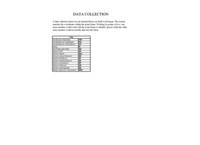
A data collection sheet was developed before our field work began. The system matches the coordinates within the point frame. Working in groups of two, one team member would work with the point frame to identify species while the other team member would record the data into the sheet. (Photo: Jeremy Monsma, Theresa Miller, Jillian Puszykowski, Erik Jones)
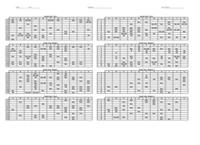
(Photo: Jeremy Monsma, Theresa Miller, Jillian Puszykowski, Erik Jones)
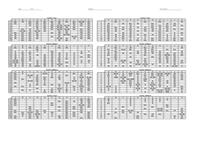
(Photo: Jeremy Monsma, Theresa Miller, Jillian Puszykowski, Erik Jones)
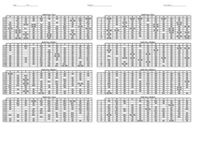
(Photo: Jeremy Monsma, Theresa Miller, Jillian Puszykowski, Erik Jones)
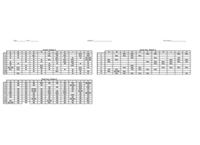
(Photo: Jeremy Monsma, Theresa Miller, Jillian Puszykowski, Erik Jones)
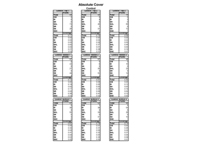
After all the data was collected, it was organized into different totals. From the organized information we were able to calculate the total absolute cover for the different species, as well as for the different areas. (Photo: Jeremy Monsma, Theresa Miller, Jillian Puszykowski, Erik Jones)
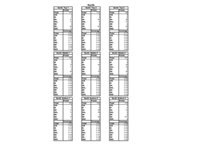
South (Photo: Jeremy Monsma, Theresa Miller, Jillian Puszykowski, Erik Jones)
"This is real science and would have a big impact. Very rigorous research."
— 2009 Student Awards Jury
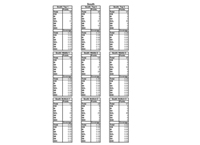
North (Photo: Jeremy Monsma, Theresa Miller, Jillian Puszykowski, Erik Jones)
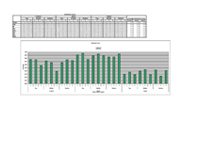
(Photo: Jeremy Monsma, Theresa Miller, Jillian Puszykowski, Erik Jones)
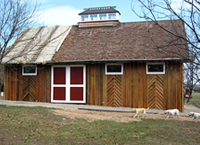
The South-facing roof in itís entirely. The barn is used for a variety of separate research projects conducted by Michigan Stateís department of landscape architecture. An image of a test runs in the Michigan State Green Houses. It was important for the team members to become familiar with the point frame method of identification and recording. (Photo: Jeremy Monsma, Theresa Miller, Jillian Puszykowski, Erik Jones)
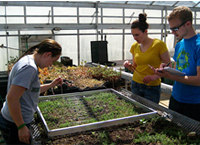
An image of a test runs in the Michigan State Green Houses. It was important for the team members to become familiar with the point frame method of identification and recording. (Photo: Jeremy Monsma, Theresa Miller, Jillian Puszykowski, Erik Jones)
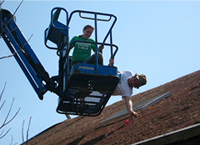
The lightweight skewers used to collect data were sometimes swept away with the wind. One group member grabs onto the crane for dear life and takes the plunge to save one. (Photo: Jeremy Monsma, Theresa Miller, Jillian Puszykowski, Erik Jones)
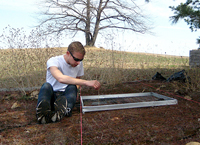
Applying the skewer, one group member observed which species were present while another recorded the results. Using the constructed point fame, data was systematically collected and then recorded. (Photo: Jeremy Monsma, Theresa Miller, Jillian Puszykowski, Erik Jones)
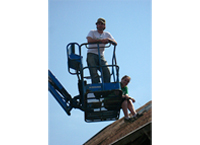
Enjoying the break just above the North-facing roof. (Photo: Jeremy Monsma, Theresa Miller, Jillian Puszykowski, Erik Jones)



